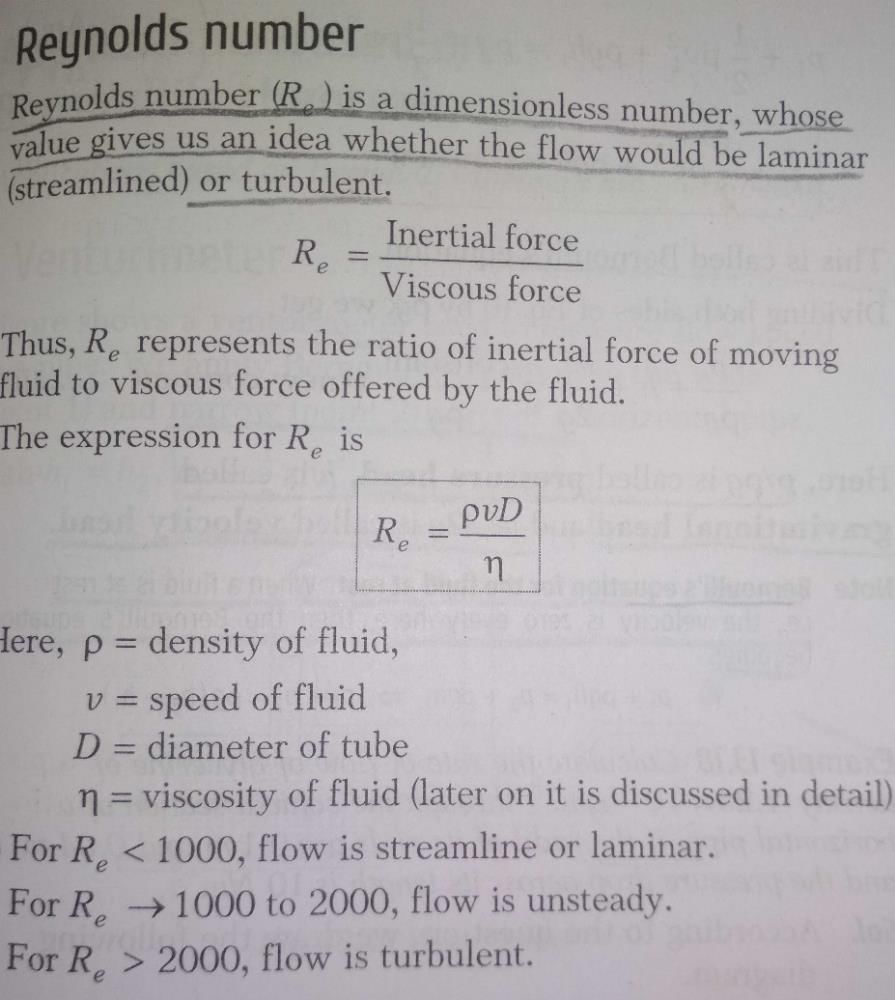Class 11 Exam > Class 11 Questions > Range of Reynold’s number for the lamin...
Start Learning for Free
Range of Reynold’s number for the laminar flow of a liquid is
- a)2000 to 3000
- b)zero to 1000
- c)1000 to 2000
- d)Zero to 2000
Correct answer is option 'B'. Can you explain this answer?
Most Upvoted Answer
Range of Reynold’s number for the laminar flow of a liquid isa)2...

Free Test
FREE
| Start Free Test |
Community Answer
Range of Reynold’s number for the laminar flow of a liquid isa)2...
Reynolds number is a dimensionless quantity that is used to determine the flow characteristics of a fluid. It is defined as the ratio of inertial forces to viscous forces and is given by the formula:
Re = (ρ * v * L) / μ
where Re is the Reynolds number, ρ is the density of the fluid, v is the velocity of the fluid, L is a characteristic length, and μ is the dynamic viscosity of the fluid.
Laminar flow is a type of fluid flow where the fluid moves smoothly in parallel layers with little to no mixing between them. It occurs at low Reynolds numbers when the viscous forces dominate over the inertial forces.
To determine the range of Reynolds numbers for laminar flow, we need to consider the transition from laminar to turbulent flow. This transition occurs when the inertial forces start to dominate over the viscous forces. The exact Reynolds number at which this transition occurs depends on various factors such as the geometry of the flow, surface roughness, and flow conditions.
In general, for the laminar flow of a liquid, the range of Reynolds numbers is typically considered to be less than 1000. This means that at Reynolds numbers below 1000, the flow will be laminar. As the Reynolds number increases beyond 1000, the flow may transition to turbulent flow.
Therefore, the correct answer to the given question is option 'B', which states that the range of Reynolds number for the laminar flow of a liquid is zero to 1000.
Re = (ρ * v * L) / μ
where Re is the Reynolds number, ρ is the density of the fluid, v is the velocity of the fluid, L is a characteristic length, and μ is the dynamic viscosity of the fluid.
Laminar flow is a type of fluid flow where the fluid moves smoothly in parallel layers with little to no mixing between them. It occurs at low Reynolds numbers when the viscous forces dominate over the inertial forces.
To determine the range of Reynolds numbers for laminar flow, we need to consider the transition from laminar to turbulent flow. This transition occurs when the inertial forces start to dominate over the viscous forces. The exact Reynolds number at which this transition occurs depends on various factors such as the geometry of the flow, surface roughness, and flow conditions.
In general, for the laminar flow of a liquid, the range of Reynolds numbers is typically considered to be less than 1000. This means that at Reynolds numbers below 1000, the flow will be laminar. As the Reynolds number increases beyond 1000, the flow may transition to turbulent flow.
Therefore, the correct answer to the given question is option 'B', which states that the range of Reynolds number for the laminar flow of a liquid is zero to 1000.

|
Explore Courses for Class 11 exam
|

|
Similar Class 11 Doubts
Range of Reynold’s number for the laminar flow of a liquid isa)2000 to 3000b)zero to 1000c)1000 to 2000d)Zero to 2000Correct answer is option 'B'. Can you explain this answer?
Question Description
Range of Reynold’s number for the laminar flow of a liquid isa)2000 to 3000b)zero to 1000c)1000 to 2000d)Zero to 2000Correct answer is option 'B'. Can you explain this answer? for Class 11 2025 is part of Class 11 preparation. The Question and answers have been prepared according to the Class 11 exam syllabus. Information about Range of Reynold’s number for the laminar flow of a liquid isa)2000 to 3000b)zero to 1000c)1000 to 2000d)Zero to 2000Correct answer is option 'B'. Can you explain this answer? covers all topics & solutions for Class 11 2025 Exam. Find important definitions, questions, meanings, examples, exercises and tests below for Range of Reynold’s number for the laminar flow of a liquid isa)2000 to 3000b)zero to 1000c)1000 to 2000d)Zero to 2000Correct answer is option 'B'. Can you explain this answer?.
Range of Reynold’s number for the laminar flow of a liquid isa)2000 to 3000b)zero to 1000c)1000 to 2000d)Zero to 2000Correct answer is option 'B'. Can you explain this answer? for Class 11 2025 is part of Class 11 preparation. The Question and answers have been prepared according to the Class 11 exam syllabus. Information about Range of Reynold’s number for the laminar flow of a liquid isa)2000 to 3000b)zero to 1000c)1000 to 2000d)Zero to 2000Correct answer is option 'B'. Can you explain this answer? covers all topics & solutions for Class 11 2025 Exam. Find important definitions, questions, meanings, examples, exercises and tests below for Range of Reynold’s number for the laminar flow of a liquid isa)2000 to 3000b)zero to 1000c)1000 to 2000d)Zero to 2000Correct answer is option 'B'. Can you explain this answer?.
Solutions for Range of Reynold’s number for the laminar flow of a liquid isa)2000 to 3000b)zero to 1000c)1000 to 2000d)Zero to 2000Correct answer is option 'B'. Can you explain this answer? in English & in Hindi are available as part of our courses for Class 11.
Download more important topics, notes, lectures and mock test series for Class 11 Exam by signing up for free.
Here you can find the meaning of Range of Reynold’s number for the laminar flow of a liquid isa)2000 to 3000b)zero to 1000c)1000 to 2000d)Zero to 2000Correct answer is option 'B'. Can you explain this answer? defined & explained in the simplest way possible. Besides giving the explanation of
Range of Reynold’s number for the laminar flow of a liquid isa)2000 to 3000b)zero to 1000c)1000 to 2000d)Zero to 2000Correct answer is option 'B'. Can you explain this answer?, a detailed solution for Range of Reynold’s number for the laminar flow of a liquid isa)2000 to 3000b)zero to 1000c)1000 to 2000d)Zero to 2000Correct answer is option 'B'. Can you explain this answer? has been provided alongside types of Range of Reynold’s number for the laminar flow of a liquid isa)2000 to 3000b)zero to 1000c)1000 to 2000d)Zero to 2000Correct answer is option 'B'. Can you explain this answer? theory, EduRev gives you an
ample number of questions to practice Range of Reynold’s number for the laminar flow of a liquid isa)2000 to 3000b)zero to 1000c)1000 to 2000d)Zero to 2000Correct answer is option 'B'. Can you explain this answer? tests, examples and also practice Class 11 tests.

|
Explore Courses for Class 11 exam
|

|
Signup to solve all Doubts
Signup to see your scores go up within 7 days! Learn & Practice with 1000+ FREE Notes, Videos & Tests.



























